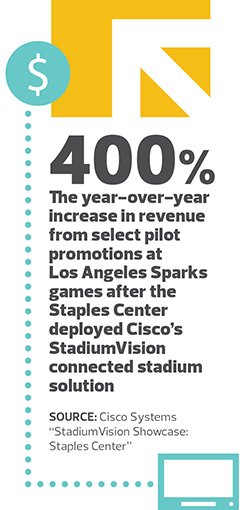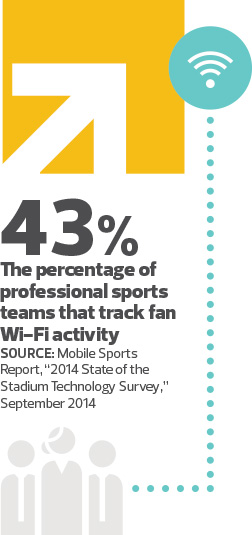Stadiums Boost Wi-Fi, Apps to Improve the Fan Experience — and Revenue
What started as a service to fans is quickly turning into a revenue driver for sports teams and entertainment venues.
In recent years, many stadiums and arenas have upgraded technology to provide quality, high-speed wireless connectivity to their customers. But today, this amenity initially designed to help fans enjoy one of the comforts of home while at the game also has teams and venues seeing benefits far beyond allowing their customers to surf the web. This new connectivity is powering a number of revenue-driving solutions, from mobile apps to digital signage and mobile point-of-sale systems. Additionally, stadium operators are collecting data that helps them better understand fans’ buying behavior, leading to targeted advertising and increased fan engagement.
The benefits of this connectivity are multifaceted, ranging from the soft gains of a better fan experience to more quantifiable advantages such as highly effective advertising and increased sales, says Chris White, general manager for Cisco Systems’ sports and entertainment group.
“As you increase revenue, you also add to the fan experience, rather than detract,” White says. “The physical and digital experiences are merging together, rather than competing with each other.”
As these solutions mature, White says, teams and venues are constantly devising creative ways to leverage technology and bring in new sources of revenue. “The marketing machine and the monetization machine are still catching up with the digital age,” he says.
Wireless Connectivity Is a Must-Have
As recently as three years ago, White says, stadium stakeholders weren’t all that sure that fans wanted mobile connectivity at sporting events or concerts. Now, it seems, that debate has been settled.
“Probably 99 percent of fans are showing up with a device,” White says. “Basic connectivity is absolutely a demand that more and more people are waking up to.”
But providing high-quality connectivity to 20,000 users or more at a given time is no simple matter.
“Stadiums are challenging because of capacity,” says Ken Rehbehn, principal analyst at 451 Research. “There’s tremendous volume. The people in the stadium are typically seated, with copious amounts of time on their hands as they watch the event. When there’s downtime, they go to their device for additional entertainment and to interact with friends. Usage just surges.”

Stadiums meet this demand by deploying numerous directional antennas capable of beaming signals to specific seating sections, or even to specific rows. While newer stadiums are being designed with fiber-optic networks to connect access points, Rehbehn says, older stadiums must be retrofitted — a potentially expensive and logistically challenging process.
During upgrades at University of Phoenix Stadium in preparation for the professional football championship game, the IT team installed more than 800 Cisco 3700 series access points.
While it’s not difficult to draw people to the pro football championship, other live sporting events face increasingly stiff competition from home viewing as broadcasts improve and high-definition televisions become commonplace. Mark Feller, vice president of technology for the Arizona Cardinals, says high-quality Wi-Fi gives fans one more reason to make the trek to the stadium, rather than staying on the couch. “We know that if people are enjoying themselves, and they have all the advantages of home, they’re going to have more fun at the stadium,” Feller says.
Creating Unique Mobile Apps
Another way to provide fans with additional value during their trip to the stadium — while also leveraging in-stadium Wi-Fi — is through custom mobile apps. Typically, these fan-focused apps provide basic information about player statistics and team schedules. They can also be designed to be interactive, providing exclusive video content and allowing fans to make purchases directly from their mobile devices.
The Cardinals’ mobile app, for instance, gives fans access to live camera angles not available on television. “It looks terrific, and the speed and quality is really good too, because our Wi-Fi system is so powerful,” Feller says.
The Kansas City Chiefs and the Indianapolis Colts are also among the teams with their own mobile apps. Both teams’ apps provide fans with access to instant replays — a popular feature, and one that helps live events compete with the home viewing experience.
John Spade, vice president of IT for the Florida Panthers, says the professional hockey team’s mobile app is “not really interactive” — at least, not yet? The app currently gives fans access to team schedules and news, but Spade hopes to add functions such as in-seat ordering. That function could help the team push out special promotions on food items, and might also lead to increased sales of team merchandise, he says. “If someone’s just scored two goals, and he might get a hat trick, people want to get a hat so they can throw it in the rink,” Spade says. If they could use the mobile app to order the hat without leaving their seat, fans may be more likely to make the purchase.
The Value of Digital Signage
Stadium operators already know the value of the signage lining their concourses, both for communicating basic information, such as the location of bathrooms and exits, and for hosting paid marketing messages from advertisers. A digital signage system that ties into a stadium’s wireless connectivity can multiply this value by giving venues the ability to change those messages at a moment’s notice.
Switching to digital signage helped the NHL’s Pittsburgh Penguins achieve a 300 percent increase in concourse advertising and sponsorship revenue, and the National Football League's Denver Broncos increased their concourse signage revenue by 50 percent after making the change.
“If you can make those messages truly engaging and relevant, that makes that stickiness and the impact so much more,” says White. “The operating cost of a stadium goes down tremendously if you’re not running around physically replacing posters. And you get to customize the marketing message, whether it’s for a country-western audience or a meat-eating ice hockey fanbase.”
In addition to tailoring advertisements to specific audiences, stadium operators can quickly change the content of digital signs during the course of a single event. If a concession stand runs out of hamburgers, for example, operators can instantly remove the item from a digital menu, helping to reduce customer frustration and speed up concession lines. Menu boards and other digital signs can also show quick replays of hockey goals or football touchdowns, so that fans don’t feel like they’re missing out when they’re in line for a beer.

Selling Anywhere Inside a Stadium
Mobile point-of-sale (mPOS) systems allow vendors to take advantage of in-stadium Wi-Fi to accept secure credit card payments from virtually anywhere inside a venue. These systems can be used by roaming vendors carrying mobile devices, and can also replace cash registers at temporary pop-up kiosks.
“Our vendors can use the private side of our Wi-Fi, and they can go where they want to inside the stadium,” says Feller. Before the Cardinals’ big Wi-Fi deployment, wireless access was limited to a few focused spots within the stadium, and vendors had to stay within those limited areas. “We were mainly using wired connections before that,” he says.
White says some stadiums, such as Barclays Center in Brooklyn, N.Y., use mPOS systems to bring in small neighborhood vendors such as microbreweries and local pizzerias. These initiatives give fans more choices while also opening up new lines of revenue for stadium operators.
“We’re finding that, when you put good, reliable infrastructure in, we’re seeing innovation and experimentation happening,” White says.
The mPOS system at Barclays Center is integrated with the arena’s digital signage system. So, if the arena begins offering fans a special on hot dogs to clear inventory late in a game, the new price is instantly reflected on vendors’ mobile devices, as well.
Additionally, mPOS systems increase the number of transactions that vendors can make during the course of a game, and can automate inventory processes.
Deriving Insights from Data
The Florida Panthers provide Wi-Fi primarily as a fan service, but Spade hopes in the near future to use that connectivity to learn more about the fans passing in and out of the team’s arena.
Teams can gather fan data in a number of ways. They can ask for email addresses in exchange for Wi-Fi access, for example, or they can design their mobile apps to integrate with fans’ social media accounts. Just by following Facebook activity at games, Spade says, the Panthers learned that a large portion of the team’s fan base likes a particular brand of whiskey — a bit of knowledge that potentially opens up new opportunities for sponsorship and advertising. “That wasn’t something that was on anybody’s radar,” he says.
“There’s strong interest from the sales and marketing teams to capture information from the users,” Spade says. Specifically, the team wants to learn more about “ghost fans,” who get their tickets from corporations, charities, friends or third-party resellers. These fans may come to several games a year without ever finding their way onto the team’s customer database, making it impossible for the Panthers to reach out to them with promotional materials about season tickets and other offers.









